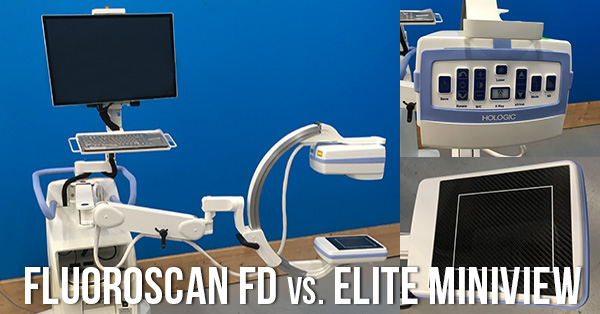
If you're looking into the purchase of a high-end mini C-arm, two of the options you'll come across in your search are the Fluoroscan Insight FD from Hologic and the OEC Elite MiniView from GE. Both of these systems are on the leading edge technology-wise and both come from heavy-hitter manufacturers that can offer quality service. So how is one supposed to pick between them? Below we'll discuss some of the advantages each of these mini C-arms offers to help you narrow down the field of options.
Storage and Travel
While both models in this comparison certainly have compact footprints, the Fluoroscan FD has a slight advantage in this regard. The FD folds and locks down smaller for storage and the monitor folds down completely flat, which offers more protection and improves visibility when the unit is being moved through busy halls.
Monitors/Viewing
The Fluoroscan FD has a single, 24" touchscreen monitor, while the Elite Miniview has dual 19" monitors, one touchscreen, the other regular. While the dual-monitor setup of the Miniview is bulkier, it also allows full-size viewing and image reference simultaneously.
Detector Movement
In addition to moving with the orbital rotation of the arm, the detector on the Fluoroscan FD also rotates laterally. This gives the system an extra dimension of flexibility within the image field, as the Miniview's detector is fixed on the end of the orbital arm.
Vertical Travel
The Elite Miniview features 10” more vertical travel than the Fluoroscan FD (33" vs. 23"), giving it more flexibility to accommodate height and load-bearing scans of a patient on their feet.
Image Storage
There's no contest in this regard. The Fluoroscan FD has an onboard image storage capacity of 10,000 images, while the Elite Miniview can store up to 100,000. It's not always necessary to have that much capacity, but during high-traffic times or when a site's ability to offload images is limited, it can come in handy.
Cost
From the OEC shutdown in the late 2000's to their return and subsequent introduction of the Miniview, OEC was without a flagship mini C-arm. Now, between the big three, Orthoscan, Hologic, and OEC, there’s a market share battle brewing. Because of this, costs have been erratic and competitive. Sometimes it's anybody’s guess as to which will be cheaper. Often though, we find the OEC is around 5-10% more. We've seen ballpark figures as follows:
Fluoroscan FD- $70,000 - $74,000
OEC Elite Miniview- $74,000 - $78,000
The Takeaway
Depending on what you value most, either of these systems could be a good fit for your facility. If your chief concerns revolve around price, conserving space, or flexibility for fine adjustments in the image field, the Fluoroscan FD is a better pick. If you're more concerned about broader movements or meeting the volume demands of a busier facility, the Elite Miniview will probably serve you better. If you're still undecided, our team is ready to help you get more information to find the very best equipment fit for your needs and preferences. Use the banner here to tell us about your project.


Gary Dodge
Gary Dodge is a C-Arm Product Manager at Block Imaging. Gary loves to consult with buyers and help them find the best solution for their C-Arm needs. Outside of the office, Gary loves trying new kinds of ethnic cuisine and visiting the Smokey Mountains with his family.




